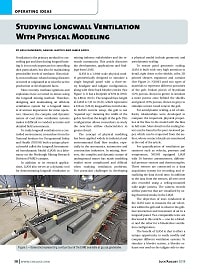Mining Publication: Studying Longwall Ventilation with Physical Modeling
Original creation date: July 2018
Authors: V Gangrade, S Harteis, J Addis
Ventilation is the primary method for controlling gas and dust during longwall mining. It is not only important for controlling dust particulates, but also for maintaining permissible levels of methane. Historically, most methane-related mining disasters occurred or originated at or near the active production or development faces.
More recently, methane ignitions and explosions have occurred in mines using the longwall mining method. Therefore, designing and maintaining an efficient ventilation system for a longwall mine is of utmost importance for mine operators. However, the complex and dynamic nature of coal mine ventilation systems makes it difficult to conduct accurate and detailed field assessments.
To study longwall ventilation in a controlled environment, researchers from the National Institute for Occupational Safety and Health (NIOSH) built a unique physical model called the Longwall Instrumented Aerodynamic Model (LIAM) in a laboratory on the Pittsburgh Mining Research Division (PMRD) campus.
In addition to its research applications, LIAM also serves as a dynamic tool for demonstrating longwall ventilation to mining industry stakeholders and the research community. This article discusses the development, applications and findings from LIAM.

- Analysis and Design Considerations for Superimposed Longwall Gate Roads
- Computational Fluid Dynamics Modeling for Underground Mines
- Degasification System Selection for U.S. Longwall Mines Using an Expert Classification System
- Design of an Optically Accessible Scaled-Version of a Longwall Coal Mine for Investigating Explosion Hazards
- Implications of Recent NIOSH Tracer Gas Studies on Bleeder and Gob Gas Ventilation Design
- Investigating the Impact of Caving on Longwall Mine Ventilation Using Scaled Physical Modeling
- Modeling and Prediction of Ventilation Methane Emissions of U.S. Longwall Mines Using Supervised Artificial Neural Networks
- Overview of Coal Mine Ground Control Issues in the Illinois Basin
- Technical Solutions for Enhancements to Mine Safety Using Barricade II Fire Blocking Gel
- Technology News 448 - Improving the Performance of Longwall Gob Gas Ventholes